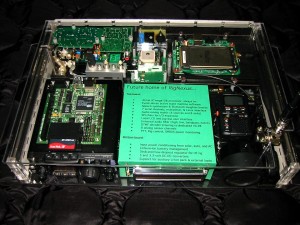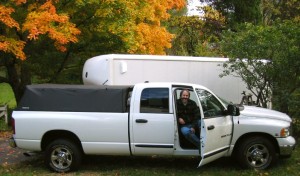P.S. Don't worry if our Tracker on findu doesn't always stay up to date. It might possibly mean that we have suffered a breakdown/accident/technical failure, but is much more likely to mean that we are out of range of participating radio stations. Hopefully our absences will be short and our little canoe icon will soon start moving again.
(For the benefit of my US readers, the title comes from the British sitcom Dad's Army)
|
|

We were driving down Interstate 5, Steve at the wheel, when my cellphone rang. 'Roz, I can see you moving! You just passed an airport. And you're breaking the speed limit.'
It was Geoff, my friend in Leeds who has been helping me out with many things including enhancements to this website. He was all a-quiver to be able to see us moving across the map in close to real-time.
The Tracker sits in a large box between the two front seats, periodically emitting modem-type noises as it sends a packet of data skipping out across the States to a server in Florida. For those of an anorakky disposition, see below for a more comprehensive description of how it works (courtesy of Steve).
It's impressive that someone sitting in their home in Leeds can virtually watch a vehicle in Washington state zipping down the freeway, and can then speak to the passenger of that vehicle to let them know what town they just passed.
I just love technology when it works.
[Photo: Gizmology - the Tracker will form part of this complete mobile communications package, known as Shacktopus, currently under development at Nomadic Research Labs]
Now for the techie bit...
APRS is pretty cool stuff. In the truck, three components work together: a GPS receiver, a 2-meter ham radio, and a Packet TNC (Terminal Node Controller). The latter is a little computer whose job is to allow text to be transmitted and received over a radio that was designed for normal voice use... like an old-fashioned modem, but with a lot more smarts, it clumps text into "packets" that are then transmitted over the air as bursts of sound. In the case of the tracker, these take a special form that includes the current latitude, longitude, and speed.
When one of these is received by another amateur radio packet station that has been dedicated to APRS use, it is immediately forwarded on... and within a few seconds the location beacon has covered hundreds of miles. Some of these stations include an Internet gateway, and, with luck, it will catch the packet and re-send it to a computer down in the Florida Keys. Steve Dimse K4HG, a friend of Steve's, is the fellow who developed that, and it disassembles the packet and inserts the location and call (in this case, N4RVE) into a database.
When you click the link from Roz's blog, the findu server displays the appropriate region from the Google Maps server, then places an icon at the most recently received location. In our case, this is a little canoe, and if all goes well it can be updated as often as once a minute.
When Geoff called us yesterday, we had a chuckle at the number of computers (including tiny embedded ones) that were involved in letting him see our location. Steve estimated that the data had passed through somewhere around 50 separate processors to bring you that little canoe zipping down I-5...
|
|
Regular visitors to this site may have noticed that we have a whole load of new menu options, leading to a wealth of new content. Geoff and I have been working hard to increase the depth of information on the site, and we hope you find it interesting.
Enjoy!
And thanks to Geoff for all his good work.
|
|

Yesterday I finally got to meet Steve Roberts, my co-driver (OK, it's his truck) for the next two months while we go to retrieve Sedna (my Atlantic rowing boat) from Miami and bring her back to the West Coast.
Steve and I have been corresponding for the last 6 weeks. He tells me that the volume of our emails now exceeds 1 MB of data. That's the kind of thing that Steve notices.
He was showing me around his workshop this morning - the centre space is dominated by his amphibious pedal/sail trimaran Microship. The rest of the workshop is occupied by cluttered workbenches, cast-off computers, circuit boards, wheels, boxes, books, bric-a-brac, and a new marine toilet awaiting installation.
Steve proudly showed me his assorted creations, particularly the communications gadgetry. I understood most of it, once I'd screened out the acronyms and jargony bits. From what I could gather, there is some pretty cool comms stuff here that would make contact possible from any point on the planet.
The hope is that while Steve is building the comms infrastructure for his new, big, ocean-going trimaran Nomadness (NOT pedal-powered) we will build a duplicate set of comms equipment for me, thus hopefully avoiding the communications blackout I suffered after my satellite phone packed up a month from Antigua.
Tomorrow we hit the road for Miami. As a taster of Steve's geeky genius, he has fitted out NEWT (New Expensive White Truck) with a tracking device so you can follow our progress in real-time as we meander our way across the US.
|
|